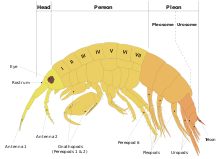Amphipoda
Amphipoda is an order of malacostracan crustaceans with no carapace and generally with laterally compressed bodies. Amphipods range in size from 1 to 340 millimetres (0.039 to 13 in) and are mostly detritivores or scavengers. There are more than 9,900 amphipod species so far described. They are mostly marine animals, but are found in almost all aquatic environments. Some 1,900 species live in fresh water, and the order also includes the terrestrial sandhoppers such as Talitrus saltator.
The name Amphipoda comes, via the New Latin amphipoda, from the Greek roots ἀμφί ("on both/all sides") and πούς ("foot"). This contrasts with the related Isopoda, which have a single kind of thoracic leg.[3] Particularly among anglers, amphipods are known as freshwater shrimp, scuds or sideswimmers.[4][5]
The body of an amphipod is divided into 13 segments, which can be grouped into a head, a thorax and an abdomen.[4]
The head is fused to the thorax, and bears two pairs of antennae and one pair of sessile compound eyes.[6] It also carries the mouthparts, but these are mostly concealed.[7]
The thorax and abdomen are usually quite distinct and bear different kinds of legs; they are typically laterally compressed, and there is no carapace.[6] The thorax bears eight pairs of uniramous appendages, the first of which are used as accessory mouthparts; the next four pairs are directed forwards, and the last three pairs are directed backwards.[6] Gills are present on the thoracic segments, and there is an open circulatory system with a heart, using haemocyanin to carry oxygen in the haemolymph to the tissues. The uptake and excretion of salts is controlled by special glands on the antennae.[4]
The abdomen is divided into two parts: the pleosome which bears swimming legs; and the urosome, which comprises a telson and three pairs of uropods which do not form a tail fan as they do in animals such as true shrimp.[6]
